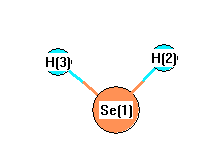Vibrational levels (cm-1) 
| Mode Number |
Symmetry |
Frequency |
Intensity |
Comment |
Description |
| Fundamental(cm-1) |
Harmonic(cm-1) |
Reference |
(km mol-1) |
unc. |
Reference |
| 1 |
A1 |
2345 |
|
Shim |
|
|
|
|
H2Se s-stretch |
| 2 |
A1 |
1034 |
|
Shim |
|
|
|
|
bend |
| 3 |
B2 |
2358 |
|
Shim |
|
|
|
|
H2Se a-stretch |
vibrational zero-point energy: 2868.5 cm
-1 (from fundamental vibrations)
Calculated vibrational frequencies for
H
2Se
+ (Hydrogen selenide cation).
Geometric Data

Point Group C2v
Internal coordinates
distances (r) in Å, angles (a) in degrees, dihedrals (d) in degrees
| Description |
Value |
unc. |
Connectivity |
Reference |
Comment |
| Atom 1 |
Atom 2 |
Atom 3 |
Atom 4 |
| rSeH |
1.460 |
|
1 |
2 |
|
|
1998Kuc |
r0 |
| aHSeH |
90.9 |
|
2 |
1 |
3 |
|
1998Kuc |
|
Cartesians
| Atom |
x (Å) |
y (Å) |
z (Å) |
| Se1 |
0.0000 |
0.0000 |
0.0569 |
| H2 |
0.0000 |
1.0405 |
-0.9673 |
| H3 |
0.0000 |
-1.0405 |
-0.9673 |
Atom - Atom Distances 
Distances in Å
| |
Se1 |
H2 |
H3 |
| Se1 |
|
1.4600 | 1.4600 |
| H2 |
1.4600 |
|
2.0809 |
| H3 |
1.4600 | 2.0809 |
|
Calculated geometries
for H
2Se
+ (Hydrogen selenide cation).
Experimental Bond Angles (degrees) from cartesians 
| atom1 |
atom2 |
atom3 |
angle |
| H2 |
Se1 |
H3 |
90.900 |
Bond descriptions
Examples: C-C single bond, C=C, double bond, C#C triple bond, C:C aromatic bond
Connectivity
| Atom 1 |
Atom 2 |
| Se1 |
H2 |
| Se1 |
H3 |
Dipole, Quadrupole and Polarizability
Electric dipole moment 
| State |
Config |
State description |
Conf description |
Exp. min. |
Dipole (Debye) |
Reference |
comment |
Point Group |
Components |
| x |
y |
z |
total |
dipole |
quadrupole |
| 1 |
1 |
1A1 |
C2v |
True |
|
|
-0.627 |
0.627 |
1969Mir/Cor:4118 |
from D2Se |
C2v |
1 |
2 |
Experimental dipole measurement abbreviations: MW microwave; DT Dielectric with Temperature variation; DR Indirect (usually an upper limit); MB Molecular beam
Calculated electric dipole moments for
H
2Se
+ (Hydrogen selenide cation).
Electric quadrupole moment 
| State |
Config |
State description |
Conf description |
Exp. min. |
Quadrupole (D Å) |
Reference |
comment |
Point Group |
Components |
| xx |
yy |
zz |
dipole |
quadrupole |
| 1 |
1 |
1A1 |
C2v |
True |
|
|
|
|
|
C2v |
1 |
2 |
Calculated electric quadrupole moments for
H
2Se
+ (Hydrogen selenide cation).
Electric dipole polarizability (Å3)  Calculated electric dipole polarizability
Calculated electric dipole polarizability for
H
2Se
+ (Hydrogen selenide cation).











